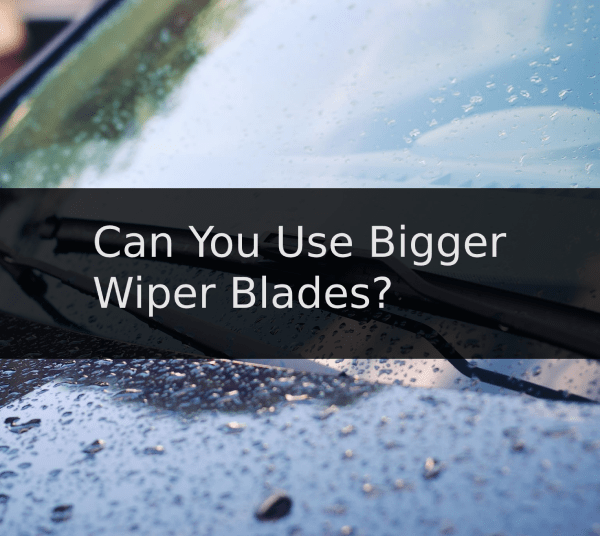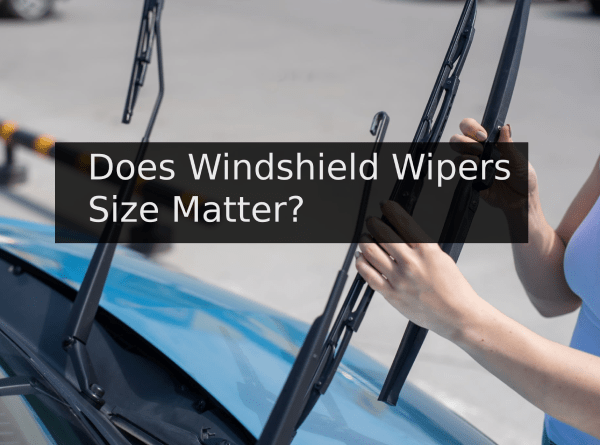A few visible parts a driver may quickly replace are the wipers. They must clear your windscreen of rain, snow, ice, dust, pollen, and other debris so you can see while driving. Since poor vision frequently results in traffic accidents, windscreen wipers, lights, and interior ventilation are essential for driving safety.
Can You Use Bigger Wiper Blades?
If you install wiper blades on your car bigger than advised, the wipers may collide and harm the wiper motor or the blades themselves. Additionally, a bigger blade may not adequately fit the window’s design, leading to visibility loss and uncleared areas.

The windshield trim may be struck by the blade too. Loss of visibility results from blades that are too narrow for the car to clear the entire windscreen. Always use wiper blades that are the proper size for your vehicle’s make, model, and year.
Does Windshield Wipers Size Matter?
It depends. As long as you are roughly an inch larger or less than the size of your present wiper blade, size counts to some extent. Wiper blades that are too large may overlap or touch, resulting in a break.

Some producers choose not to make specific sizes of wiper blades due to a lack of demand from automakers. For instance, Bosch does not produce 17-inch wiper blades, therefore, purchasing a 16- or 18-inch blade is perfectly OK.
The influence on the size difference will be minimal because there will only be a half-inch variation on either side. In rare instances, it is feasible to stray from the automaker’s suggested windshield wiper blade size without endangering the security and effectiveness of your blades.
To make this work, you must select blades whose sizes don’t differ much from those your vehicle’s manufacturer advised. Typically, it’s advised to select blades no more than an inch larger or less than the manufacturer suggests.
Why Do Cars Have Different Size Wiper Blades?
You’ll see that the driver’s side wiper is near the windshield’s side edge. This is because the wiper arm only rotates to a 90-degree perpendicular before it snaps back to its starting position. That is essential. Windshield wiper blades are available in various lengths due to where the wiper arms are placed.
If the wipers were equal in size and positioned in the middle of the windshield, the top center and top corners of the glass would go uncleaned. The trajectories of the two wipers would also cross each other.
Vehicle designers have discovered the ideal configuration to clear the greatest windshield area, particularly on the driver’s side, by adjusting the position and course of the wipers. As a result, different wiper sizes are required to match those places.
What Happens If You Get The Wrong Wiper Blade Size?
Using the incorrect size won’t result in anything bad. You will either experience a reduced wiping area, or the additional 1″ length could get in the way of the second wiper or the windshield’s edges. If that happens, you can tell from the loud noises and the jerky movement of the wiper.
In conclusion, choosing the incorrect wiper size is not a good idea, but it won’t result in any immediate or significant harm you should be concerned about.
How Do I Know What Size Wiper Blade I Need?
Vehicle-specific wiper blades are used for windshields. Some cars will use the same size for both wiper blades, while others might use different-sized blades. The manufacturer chooses the best-fitting wiper blade size to clear as much of the windshield as possible.
You will discover that one or both wiper blades will hang over the side or touch the top of the windshield trim while upright if you change your wiper blades with a larger blade to clear more space on the windshield.
Furthermore, if both windshield wipers are longer than the recommended size, they could bump into each other and harm the wiper motor, arms, and blades. The wiper blades will experience significant wear as a result.
The size of your windshield wipers will vary based on the make, model, and year of your car, so it’s critical to know which size you require before replacing them. In addition, the wrong blades might not do their job as intended, causing a potential hazard when driving in the rain.
When it comes to selecting the ideal blades for your car, you have a few options:
Take The Wiper To The Parts Store
This is probably the most obvious thing to do. Take your old wiper blades to any auto-parts store, and the employees will surely be there to help you. You won’t even have to know the right size. This option assumes you do know how to remove the wiper blades yourself.
If not, just drive to one of the national service chains, such as Autozone, and they will take care of your car.
Check Your Owner’s Manual
The owner’s manual for your car should specify the size of the wiper blades you need for each side and may even suggest a particular brand. Before replacing the blades, read the instructions carefully, as certain vehicles have different size requirements for the driver and passenger sides.
Utilize a Tool
To help you acquire the right-sized blades the first time, you can use various online tools, or you can go to your local parts store and use the books and touchpad systems there.
Ask a Tech
If in doubt, get advice from someone familiar with vehicles similar to yours, such as a certified service technician. Then, you can install your wipers if that is what you want. Use the directions on the wiper packaging’s back or follow our step-by-step instructions to finish the task quickly.
What Are The Most Common Wiper Blade Sizes?
To ensure safe driving circumstances, most specialists advise sizing your blade as closely as is practical to the manufacturer’s recommendations. Once you know the exact specs, you can pick between buying universal blades that are the right length for some automobiles or buying blades that are specifically made for your car.
The size of the wiper set and whether it is for the front or back of the car are both given in millimeters. To give the driver the best vision possible, the blades on the driver’s side extend further than those on the passenger side.
A guidance chart with different wiper blade sizes helps someone choose the correct blade for their vehicle because windshield wipers are a crucial safety element, especially when driving in severe weather.
Wiper sizes range from 10 to 32 inches, and the windshield wiper blade is measured in inches. The recommended blade length is always listed in the car’s owner’s manual because if you select one that is too short, your field of view will be reduced, and the screen won’t be properly cleaned.
The most obvious way to distinguish between wiper blades is by length.
Typical front wiper blades range in length from 16 to 28 inches. The length of a rear wiper blade ranges from 11 to 16 inches. The suggested size can differ between wiper blade product lines and between manufacturers.
Although the difference isn’t as significant as it is with other fitted consumer goods, such as shoes, it’s significant enough to make it crucial to check the size chart for a certain brand
For example, even though your automobile arrived with 22-inch wiper blades, a specific brand may call for 21- or 23-inch blades. It’s good to get the wiper blade length right. Instead, use the blade’s manufacturer’s suggested size.
How Often Should You Replace Wiper Blades?

Wiper blade replacement should generally be done every six to twelve months. Nevertheless, this depends on both the blades’ material and the weather. The lifespan of silicone blades may exceed a year even under heavy use, while that of regular rubber blades is the shortest, followed by halogen-hardened rubber and then regular rubber again.
So, naturally, they are more expensive than regular rubber blades. Also, you could need to change them sooner depending on where you reside and how frequently you drive. The windshield wipers on your automobile also affect how frequently you need to replace them, with beam wiper blades typically outlasting conventional ones.
Checking your wiper blades each time you get an oil change is an excellent method to remember when to replace them. Also, physical indications point out that your wipers need to be replaced.
Corroded Metal
Although your windshield wipers’ arms and “joints” rusting and corroding won’t immediately reduce your visibility, it is a clue that their structural integrity is at risk!
When driving, a rusted wiper blade frame will likely fall off, leaving you without a blade and even putting you in danger of colliding with another car or a pedestrian.
So each time you see any rust or discoloration on the metal components of your wiper blade frames, bring them into Firestone Complete Auto Care.
Screechy Chattering
Do your windshield wipers make a chalkboard-like noise? If so, your issue might be more complex than it first appears. For example, wiper blades screeching or chattering may indicate that the wiper arms are bent.
Undue streaking
After each pass, the wiper should leave a smooth, clean surface. In addition to making it easier to notice, streaks show that the blade has lost some of its sharpness. Consider wet spots to be a more severe form of streaking.
The blade is so damaged that it can no longer remove moisture. In some places, you essentially no longer have a wiper. You should frequently replace your windshield wipers even if they don’t exhibit any of these symptoms. This inexpensive component aids in your safety.
Sources
What Size Windshield Wipers Do I Need?
How Often To Chance Wiper Blades?
Wiper Blades Size chart by type, model and brand
Every since I was a little boy, I can remember spending the afternoons in my dad’s repair shop. I got my first car at 16 and it was the best feeling ever!
I have contributed to various automotive publications but decided it’s finally time to settle for something constant.








